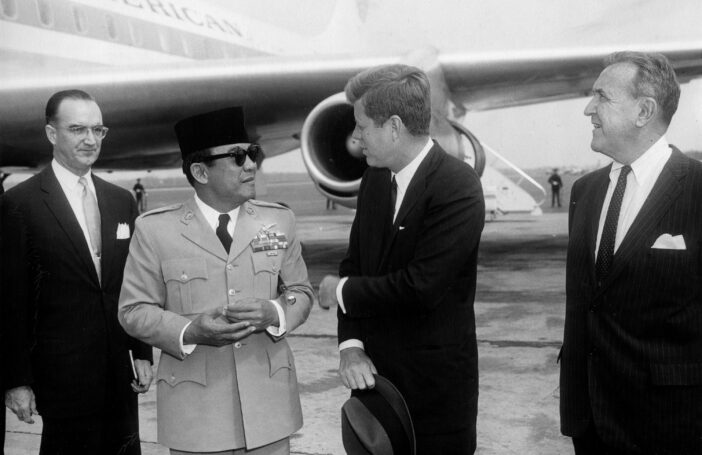Sitting on my shelves is a book entitled Kennedy, Johnson, and the Nonaligned World, authored by Stanford University historian Robert Rakove and published in 2012. I purchased the book several years ago, read and enjoyed it, and then dutifully placed it back on the shelf with a bunch of other books on United States politics and history, several of which still remain unread.
I was recently re-reading the book’s chapter on development assistance, “‘Our most difficult political battle’: the question of aid”. It seemed very pertinent to today’s world of renewed geopolitical competition, great power rivalry and lots of talk about “integrated statecraft”. The chapter deals with both administrations’ efforts to balance, on the one hand, a policy view that in order to boost the global image of the United States, overseas development and infrastructure projects should be divorced from political conditions and quid pro quos and, on the other, the argument that “aid should purchase some degree of allegiance”.
In the context of the Cold War of the early 1960s, the more transactional view was predominant among aid sceptics in the Congress and some in the national security establishment. It was geared towards the use of aid to secure explicit support for anti-communist efforts, or at least “genuine” neutrality, from nonaligned countries and leaders such as Gamal Abdel Nasser in Egypt, Jawaharlal Nehru in India and Sukarno in Indonesia. This was seen as particularly important in the wake of the 1956 Suez crisis, which was attributed to the US and British decision to renege on their previous agreement to finance Egypt’s high-profile Aswan Dam project.
For his part, President John F. Kennedy, a disciple of Walt Rostow’s Stages of Economic Growth, was a genuine believer in foreign aid. He proposed to make the 1960s “the crucial Decade of Development”, introduced the 1961 Foreign Assistance Act, and created the US Peace Corps. But Kennedy was constrained by those in the Congress and elsewhere who demanded that America’s aid be reciprocated by client countries in the form of explicit policy concessions. Writing to Nehru in 1961, Kennedy attempted to subtly convey this need for reciprocity:
Each year our appropriations to help, not India alone, but also other developing countries of the world, involve our most difficult political battle … I hope you will agree that we have a common interest in maintaining the political atmosphere and the public attitudes that are sympathetic to this effort.
In approving US funding for the Volta River Dam in Ghana in 1961, Kennedy similarly sought from Prime Minister Kwame Nkrumah “a reciprocal commitment to rhetorical moderation and ‘true’ nonalignment”.
Of course, these conditions were entirely unacceptable to most nonaligned leaders, many of whom were worried about their own domestic political standing and nationalist credentials. They also directly contradicted the US’s public “no strings attached” rhetoric. In Rakove’s account, Kennedy found it increasingly difficult to thread this needle and, by the time of his assassination in 1963, prominent nonaligned leaders continued to publicly denounce US imperialism (while still accepting its aid). In response, the Congress had used its budget powers to curtail key elements of the President’s ambitious development agenda. This included the cancellation of US financing for the Bokaro steel mill in India, a major aid project which ended up being funded by the USSR.
In his last press conference in November 1963, Kennedy argued against attempts to link aid to the foreign policy decisions of nonaligned states: “I don’t think threats from Capitol Hill bring the results which are frequently hoped … [as] at the time the Aswan Dam was cut off.”
President Lyndon B. Johnson, an aid sceptic when compared to Kennedy, was more willing to explicitly use America’s aid as a bargaining chip. Rakove notes that while Kennedy was able, on occasion, to draw a distinction between the approach of the executive and legislative branches, “Johnson’s tactics erased this distinction: after 1964 both branches seem keen to use aid coercively”. But Johnson would face a similar dilemma to Kennedy, as leaders proved unresponsive to his attempts to directly link aid to Cold War concessions from their nonaligned states. His efforts to do so largely failed with Egypt and created deep resentment among India’s elite, arguably driving it closer to the USSR. And Johnson’s cuts to aid to Indonesia in 1964 failed to dissuade Sukarno from continuing his attacks on Malaysia and the policy of konfrontasi.
Ultimately, Rakove argues, by 1965 “without exception, this tactic [had] backfired. By its own actions, the US government had thrown Kennedy’s pledges into disrepute throughout the nonaligned world – just as Johnson began to deploy ground troops in South Vietnam.” It also deepened disillusionment within the Congress, undermining efforts to reform aid along more technocratic lines. This included a push in 1965 by Senator J. William Fulbright, who argued for a greater shift to multilateral channels to “alleviate the difficulties that aid created within bilateral relationships”.
So, what might be the lessons for today? To me, Rakove’s history of this fascinating period in US diplomacy highlights the inherent risks associated with trying to maintain two contradictory narratives around the purpose of foreign aid – one that donors tell recipient countries and the public (development impact, “no strings attached”), and one that they use for domestic elite consumption (tactical geopolitical advantage, “carrots and sticks”). The danger is that in attempting to do both, aid achieves neither. Best to stick to one clear (public and private) purpose – development impact – resource it, and deliver on it.
This is easier said than done, given the fragility of the authorising environment for aid in many donor countries, including Australia. And it may or may not represent good “statecraft”. But it would be good policy, and it would be in the national interest.
This is the first blog in a series on Cold War aid.




